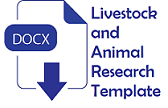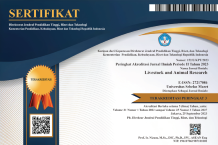Experimental animal models for polycystic ovarian syndrome (methods, effects, and implications)
Abstract
Many studies have replicated the clinical and genetic features of polycystic ovarian syndrome (PCOS) using a range of experimental animal models to improve treatment outcomes. This article aims to present an overview of the various experimental animal models that have been used in PCOS research. In this study, we conducted a systematic review of relevant research articles on the induced animal model PCOS. We searched research articles in Indonesian and English published over the last five years through three databases: PubMed, ScienceDirect, Google Scholar. We use established inclusion and exclusion criteria to select suitable articles. Out of 19 research articles included in our systematic review, we found the animal model PCOS based Rotterdam criteria, PCOS-IR model, PCOS-Inflammation model, PCOS-Gut microbiota model and PCOS-syndrome metabolic model. Androgen agents such as testosterone propionate, free testosterone, DHEA, and letrozole, as well as sodium valproate, are effective in the induction of PCOS phenotypes based on the Rotterdam criteria (oligo/amenorrhea, hyperandrogenic, and polycystic ovaries).
Keywords
Full Text:
PDFReferences
- De Leo, V., M. C. Musacchio, V. Cappelli, M. G. Massaro, G. Morgante, and F. Petraglia. 2016. Genetic, hormonal and metabolic aspects of PCOS: an update. Reprod. Biol. Endocrinol. 14(1):1-7. Doi: 10.1186/s12958-016-0173-x
- Chen, W. and Y. Pang. 2021. Metabolic syndrome and PCOS: pathogenesis and the role of metabolites. Metabolites. 11(12):869 Doi: 10.3390/METABO11120869
- PK, H. T, L. Unnikrishnan, M. Pangath, K. Vasudevan, S. Jayaraman, M. Li, A. Iyaswamy, K. Palaniyandi, and D. Gnanasampanthapandian. 2022. The epigenetic correlation among ovarian cancer, endometriosis and PCOS: A review. Crit. Rev. Oncol. Hematol. 180:103852. Doi: 10.1016/j.critrevonc.2022.-103852
- Kurniawati, E. Y., S. Hadisaputro, and A. Suwandono. 2019. The effect of holistic programs on cortisol serum levels in polycistic ovarium syndrome. Indones. J. Med. 4:376–382. Doi: 10.26911/THEIJMED-.2019.04.04.11.
- Higgins, J. P. T., J. Thomas, J. Chandler, M. Cumpston, T. Li, M. J. Page, and V. A. Welch. 2019. Cochrane handbook for systematic reviews of interventions. The Cochrane Collaboration. 1–694. Doi: 10.1002/9781119536604
- Sterne, J. A. C., J Savović, M. J. Page, R. G. Elbers, N. S. Blencowe, I. Boutron, C. J. Cates, H. Y. Cheng, M. S. Corbett, S. M. Eldridge, and J. R. Emberson. 2019. RoB 2: A revised tool for assessing risk of bias in randomised trials. BMJ. 366. Doi: 10.1136/BMJ.L4898
- Porter, D. T., A. M. Moore, J. A. Cobern, V V. Padmanabhan, R. L. Goodman, L. M. Coolen, and M. N. Lehman. 2019. Prenatal testosterone exposure alters GABAergic synaptic inputs to GnRH and KNDy neurons in a sheep model of polycystic ovarian syndrome. Endocrinol. 160:2529–2542. Doi: 10.1210/EN.2019-00137
- Chu, W., J. Zhai, J. Xu, S. Li, W. Li, Z. J. Chen, and Y. Du. 2020. Continuous light-induced PCOS-like changes in reproduction, metabolism, and gut microbiota in Sprague-Dawley Rats. Front Microbiol. 10:3145. Doi: 10.3389/FMICB.-2019.03145
- Bakhi, E. S., N. H. Roodbari, M. Anvari, and F. R. Tehrani. 2023. Prenatal kisspeptin antagonist exposure prevents polycystic ovary syndrome development in prenatally-androgenized rats in adulthood: An experimental study. Int. J. Reprod. Biomed. 21(2):99–110. Doi: 10.18502/ijrm.v21i2.12801
- Ullah, A., M. J. Wang, J. P. Yang, E. A. Adu-Gyamfi, A. Czika, S. K. Sah, Q. Feng, and Y. X. Wang. 2022. Ovarian inflammatory mRNA profiles of a dehydroepiandrosterone plus high-fat diet-induced polycystic ovary syndrome mouse model. Reprod. Biomed. 44(5):791–802. Doi: 10.1016/j.rbmo.2021.10.024
- Palmerini, M. G., G. Macchiarelli, D. Cocciolone, I. A. Mascitti, M. Placidi, T. Vergara, G. Di Emidio, and C. Tatone. 2023. Modulating morphological and redox/glycative alterations in the PCOS uterus: effects of carnitines in PCOS mice. Biomed. 11(2):374. Doi: 10.3390/BIO-MEDICINES11020374
- Kim, E-J., M. Jang, J. H. Choi, and K. S. Park. 2018. An improved dehydroepiandrosterone-induced rat model of polycystic ovary syndrome (PCOS): Post-pubertal improve PCOS’s features. Front. Endocrinol. 9:735. Doi: 10.3389/fendo.2018.00735
- Wang, X., L. Gu, Y. Zhang, C. Xiong, Y. Peng, and X. Ding. Effects of dehydroepiandrosterone alone or in combination with a high-fat diet and antibiotic cocktail on the heterogeneous phenotypes of PCOS mouse models by regulating gut microbiota. Front. Endocrinol. 13:1030151. Doi: 10.3389/-fendo.2022.1030151
- Zhou, D. N., S. J. Li, J. L. Ding, T. L. Yin, J. Yang, and H. Ye. 2018. MIF may participate in pathogenesis of polycystic ovary syndrome in rats through MAPK signalling pathway. Curr. Med. Sci. 38:853–60. Doi: 10.1007/s11596-018-1953-7
- Decourt, C., Y. Watanabe, M. C. Evans, M. A. Inglis, L. C. Fisher, C. L. Jasoni, R. E. Campbell, and G. M. Anderson. 2023. Deletion of androgen receptors from kisspeptin neurons prevents PCOS features in a letrozole mouse model. Endocrinol. 164(6):bqad077. Doi: 10.1210/-endocr/bqad077
- Ryu, K. J., H. Park, Y. I. Han, H. J. Lee, S. Nam, H. G. Jeong, and T. Kim. 2023. Effects of time-restricted feeding on letrozole-induced mouse model of polycystic ovary syndrome. Sci. Rep. 13(1):1943. Doi: 10.1038/s41598-023-28260-5
- Ibrahim, Y. F., M. Alorabi, W. Y. Abdelzaher, N. D. Toni, K. Thabet, A. Hegazy, H. A. Bahaa, G. E. Batiha, N. N. Welson, M. A. Morsy, and K. N. Venugopala 2022. Diacerein ameliorates letrozole-induced polycystic ovarian syndrome in rats. Biomed. Pharm. 149:112870. Doi: 10.1016/J.BIOPHA.2022.-112870
- Sudhakar, P., R. Kothai, and V. Thenmozhi. 2019. Development of an animal model for polycystic ovarian syndrome in relation to reproductive and metabolic phenotype. J. Pharm. Sci. Res. 11:2827–32.
- Esparza, L. A., D. Schafer, B. S. Ho, V. G. Thackray, and A. S. Kauffman. 2020. Hyperactive LH pulses and elevated kisspeptin and NKB gene expression in the arcuate nucleus of a PCOS mouse model. Endocrinol. 161:bqaa018. Doi: 10.1210/-endocr/bqaa018
- Wang, M. X., Q. Yin, and X. Xu. 2020. A rat model of polycystic ovary syndrome with insulin resistance induced by letrozole combined with high fat diet. Med. Sci. Monit. 26: e922136-1. Doi: 10.12659/-MSM.922136
- Dos Santos, J. T., J. E. Da Nóbrega, L. K. S. Mujica, C. D. S. Amaral, F. A. Machado, M. W. Manta, T. M. Rizzetti, R. Zanella, R. Fighera, A. Q. Antoniazzi, and P. B. Gonçalves. 2018. Prenatal androgenization of ewes as a model of hirsutism in polycystic ovary syndrome. Endocrinol. 159:4056–64. Doi: 10.1210/EN.2018-00781
- Marshall, C. J., M. Prescott, and R. E. Campbell. 2020. Investigating the NPY/AgRP/GABA to GnRH neuron circuit in prenatally androgenized PCOS-like mice. J. Endocr. Soc. 4:1–12. Doi: 10.1210/JENDSO/BVAA129
- Linares, R., G. Rosas, E. Vieyra, D. A. Ramírez, D. R. Velázquez, J. A. Espinoza, C. Morán, R. Domínguez, and L. Morales-Ledesma. 2019. In adult rats with polycystic ovarian syndrome, unilateral or bilateral vagotomy modifies the noradrenergic concentration in the ovaries and the celiac superior mesenteric ganglia in different ways. Front. Physiol. 10:1309. Doi: 10.3389/FPHYS.2019.01309
- Asghari, R., V. Shokri-Asl, H. Rezaei, M. Tavallaie, M. Khafaei, A. Abdolmaleki, and A. M. Seghinsara. Alteration of TGFB1, GDF9, and BMPR2 gene expression in preantral follicles of an estradiol valerate-
induced polycystic ovary mouse model can lead to anovulation, polycystic morphology, obesity, and absence of hyperandrogenism. Clin. Exp. Reprod. Med. 48:245–54. Doi: 10.5653/cerm.2020.-04112 - Ding, Y., Z. Jiang, B. Xia, L. Zhang, C. Zhang, and J. Leng. Mitochondria-targeted antioxidant therapy for an animal model of PCOS-IR. Int. J. Mol. Med. 43:316–24. Doi: 10.3892/ijmm.2018.3977
Refbacks
- There are currently no refbacks.










